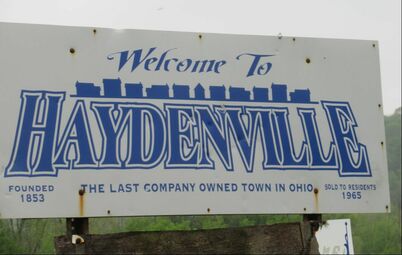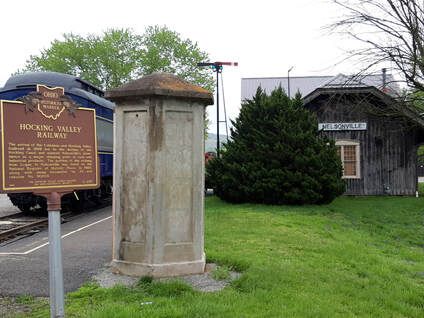 Coal company tipple. Coal company tipple. Maybe the best way to introduce the history of the Little Cities is through the eyes of one of the main characters of my book in progress with the working title of Little Diamonds. The story begins in the battlefields of World War I, but Dewey Powell is now on a train returning home to the Little Cities of Black Diamonds. Dewey’s Return The tipples were the first thing he saw when he opened his eyes. Dewey looked at his watch and saw that it was ten o’clock. He’d dozed off to the clickety-clack of the train on the tracks after breakfast. The train creaked as it turned a corner on the rails. Since New York City they had entered Ohio through Youngstown and Canton before landing in Columbus several days ago for the parade and celebration welcoming hundreds of returning soldiers home at the Capital building.  Established by Peter Hayden, Columbus Industrialist Established by Peter Hayden, Columbus Industrialist He looked out the train window again. Now, the hills, occasional oil rigs, clay factories, and more frequent coal tipples told him he was almost there. In an area of only fifteen square miles, more than seventy small crossroads, towns, and large mining communities in sections of Perry, Hocking, Athens and Morgan counties were known as the Little Cities of Black Diamonds. Ancient glaciers had created a region of narrow valleys and high hills to form the western foothills of the Appalachian Mountains. The farming wasn’t good, but the coal, clay, oil and natural gas below the surface were rich. The region started when the Hocking Valley Railroad arrived in 1869. Other railroads followed into the valleys and hollows where the coal was. Every time a man bought a new piece of land to dig, he’d give it a name, often his own, and a town would grow up around it. Most were company owned towns with fewer than two-thousand residents and relied entirely on coal for employment. It began on a single main street with homes, churches, and schools. Always centrally situated was the railroad depot.  Nelsonville depot today Nelsonville depot today The train slowed down as it reached the Nelsonville train depot. Dewey saw the old opera house and the town square where, like other cities in the region, commercial buildings had second story porches attached by decorative brackets. A man stood on one waving a Knights of Labor banner. Newly paved streets led up to the depot which was filled with a variety of friends, families, and curious on-lookers. You could tell the buggy drivers and mail clerks from the idlers. A baggage handler was reading a newspaper in the sun until the next mailbag arrived. An express boy walked anxiously alongside the train. The station agent could see approaching trains from either direction from a bay window on the east track side. Station signs attached to the depot showed mileage to the line’s eastern extreme in West Virginia and on the other end of the depot was another, showing the next western stop in Ohio. As the train whistle sounded, Dewey put his head out the window and could feel the steam from the engine as it slowed to a halt. Sailors and soldiers jumped off the train to cacophonous cries from the crowd. Place and Location as a Character Many stories are so connected to a location that a place becomes one of the characters, and such is the case with Little Cities of Black Diamonds. But this region provides characters of many places, each with their own history and story. To those of us who are passionate about preserving the past, each are diamonds of another type. Their history reflects issues in the nation’s past-- unionization, African-American and European-ethnic heritage, the consequences of a one-product economy, rural transportation—to name a few. I hope you will enjoy reading about these characters of place as much as I enjoy learning and writing about them. Next Time: Appalachia North
Ann Otto writes fiction based on factual as well as oral history. Her debut novel, Yours in a Hurry, about Ohioans relocating to California in the 1910’s, is available on-line at Amazon, Barnes & Noble, Kindle, and at locations listed on her website at www.ann-otto.com. Ann’s academic background is in history, English, and behavioral science, and she has published in academic and professional journals. She enjoys speaking with groups about all things history, writing, and the events, locations, and characters from Yours in a Hurry. She is currently working on her next novel about Ohio’s Appalachia in the 1920’s and prepared for future works by blogging about a recent World War 2 European tour. She can be reached through the website, or on Facebook @Annottoauthor or www.Goodreads.com.
0 Comments
|
Archives
August 2020
Categories
All
|
 RSS Feed
RSS Feed